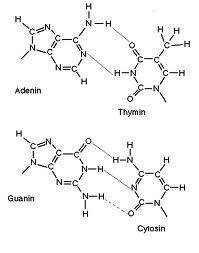Watson-crick base pairing


DNA consists of two types of bases namely; purines and pyrimidines. There are two types of purines: adenine and guanine as well as two types of Pyrimidines: cytosine and thymine. In the Watson-Crick DNA base pairing model a purine always binds with a pyrimidine, however, each purine binds to one particular type of pyrimidine.
Adenine (A) binds to thymine (T) whilst, guanine (G) binds to cytosine (C); although in RNA unracil (U) is substituted for thymine (T). This base pairing is referred to as complementary, hence the base pairs are called complementary base pairs [1]. The base pairs are bound by hydrogen bonds, although the number of H-bonds differs between base pairs. G-C base pairs are bound by three (3) hydrogen bonds whilst, A-T base pairs are bound by two (2) hydrogen bonds as illustrated in the figure on the right.
Importance
Watson-Crick base pairing is of very great importance as it is a deciding factor in DNA Replication [2]. It ensures that pairs form between complementary bases only. The formation of base pairs between two non-complementary bases results in gene mutations which can be detrimental to development of an organism.
References
- ↑ Hartl D., Ruvolo M. (2012) Genetics; Analysis of Genes and Genomes, 8th edition, Burlington: Jones and Barlett.
- ↑ Genetic Science Learning Center (2011) Build a DNA Molecule. Learn.Genetics. Available at: http://learn.genetics.utah.edu/content/begin/dna/builddna/. [Last assessed: 26/11/2011] University of Utah